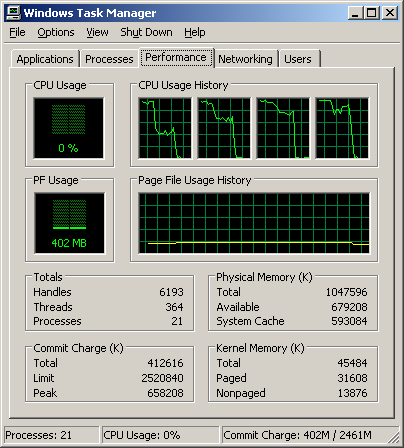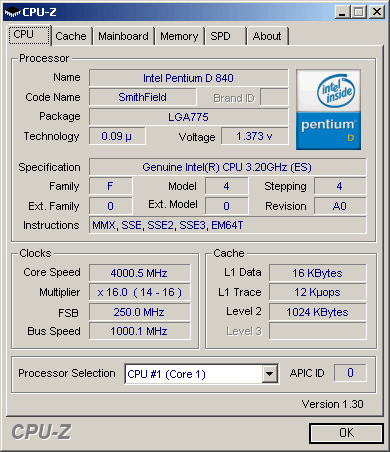The Mother of All CPU Charts 2005/2006
Two Cores, Sharing A Home: The Dual Core 800 Series, Continued
Thanks to Intel's Hyper Threading technology, the user has four virtual processors at his disposal.
Although the new processor's codename Smithfield implied a completely new design, the reality is that the CPU consists of two Prescott cores with 1 MB of L2 cache; no features such as additional instruction sets were added. The regular Pentium D also lost its Hyper Threading capability, which is an exclusive feature of the Extreme Edition, making this the only difference between the Pentium D and the Pentium EE of the 800 series except for the latter coming with a freely selectable multiplier. The latter is only available as the 840 model running at 3.2 GHz.
Just like in dual Xeon systems, the two cores communicate via the FSB. Since this bus is rather slow, running at a mere 200 MHz (800 MHz in quad data rate mode), and since the CPU's maximum clock speed was 3.2 GHz, the resulting performance was somewhat disappointing. The reason for the comparatively low clock speed can be found in the processor's high thermal power loss - with a TDP of 130 watts, it pushes today's boxed coolers to their limits. Meanwhile, Intel has attempted to address the situation by increasing the diameter of the cooler's copper core.
To eke out a little more performance compared to the 600 series, Intel raised the memory frequency to DDR2 667 (333 MHz) with the 945/955 platform. Despite this step, the memory performance of the 800 series is roughly 5% worse than that of its sibling, due to the front side bus that the cores are forced to share.
The power hunger of the two cores required the introduction of a new power connector to supply the core voltage. Thus, the 8-pin power plug found in server systems made its appearance on the desktop. Hardware retailers are undoubtedly thrilled, as this means that buyers will take home not only a new CPU but also a new power supply following the ATX 12V 2.2 standard.
Since there is still a pronounced lack of software for the desktop that actually takes advantage of two CPUs, these processors remained largely unattractive to buyers. Indeed, as our benchmarks showed, the two year-old Pentium 4 based on the Northwood core actually offered completely identical performance in single-threaded applications. The dual-core Pentium is only able to flex its muscles in specialized applications such as the MainConcept encoder or any applications in the professional space. However, when several CPU-intensive tasks are run in parallel, the Pentium D proves to be the superior processor.
As testing in the THG lab showed, even the earliest samples that were available to us could easily be overclocked to 4 GHz, so obviously there's still headroom. Rather, the thermal power loss seems to be the limiting factor, as it results in a very high temperature concentrated on the small area of the CPU. Premium professional-grade water-cooling systems with two large actively cooled radiators are necessary to dissipate this much heat.
Get Tom's Hardware's best news and in-depth reviews, straight to your inbox.
Current page: Two Cores, Sharing A Home: The Dual Core 800 Series, Continued
Prev Page Two Cores Sharing A Home: The Dual Core 800 Series Next Page Extreme Edition: Extreme Extra Performance?Tom's Hardware is the leading destination for hardcore computer enthusiasts. We cover everything from processors to 3D printers, single-board computers, SSDs and high-end gaming rigs, empowering readers to make the most of the tech they love, keep up on the latest developments and buy the right gear. Our staff has more than 100 years of combined experience covering news, solving tech problems and reviewing components and systems.



